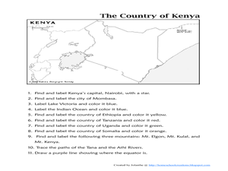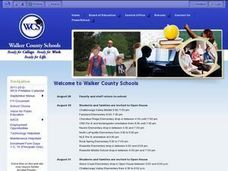Curated OER
Layers of Time in the Earth
Students are introduced to the concept of stratification as a historical and geological process. Students will read about the Richard Beene archaeological site, which lies near San Antonio, Texas on the Medina River, and watch a short...
Curated OER
Optional Laboratory: Soil Particle Size and Texture
Students work together to perform experiments on different types of soil. They record the soil's pH level, color and texture. They develop hypothesis' on what they believe they will discover before beginning the experiment.
Curated OER
Weather Mobile
Young scholars color the lightning part of the thunder cloud and then cut out the pattern. They then cut out the cloud pattern and put cotton onto it with glue. They then fold a piece of paper several times to create a snowflake to which...
Curated OER
The Driving Force
Students work in groups and note similarities and differences between their boats: size, shape, color, and unique features. They discuss 3 typical means of propulsion: propellers, sails, and paddles then share their charts with the class.
Curated OER
Concentration vs. Solubility
Students investigate the concentrations of solutions and solubility. In this concentrations and solubility lesson plan, students compare solutions of talcum powder in water and salt in water to have a visual of solubility. They perform...
Curated OER
Mathematics Within: Algebraic Patterns
Students comprehend that ratios and fractions are interchangeable. They compare ratios using common denominators, cross multiplication, and intuition. Students find equivalent fractions. They comprehend that equivalent ratios do not...
Curated OER
Mixing Colors
Students understand why we see various colors. In this mixing colors lesson, students experiment with different food coloring to explore how colors are made. Students record on a data sheet the colors they see.
Curated OER
The Country of Kenya
In this map completion worksheet, students observe a map and map scale of Kenya to find and label bodies of water, cities, countries, and the equator. Students answer 11 questions.
Curated OER
Monoprints With Markers
Young scholars make prints without a printing press. In this printmaking lesson, students make a monoprint by drawing a picture with washable markers, briefly submerging the paper under water, and pressing it onto a new sheet.
Curated OER
Mix It Up : Colors
Fifth graders make predictions of the resulting colors when colors are mixed. In this colors lesson, 5th graders discuss vocabulary related to mixing colors. Students are asked to paint a picture of five colors from two colors of...
Curated OER
Diffusion
Students investigate diffusion using different solutions of chemicals placed in agar dishes. In this diffusion lesson plan, students observe 3 demonstrations of diffusion using perfume, food coloring in water and sugar cubes in water....
Curated OER
Periodic Table
Students investigate the structure and development of the periodic table. In this periodic table lesson plan, students are given colored strips of paper that represent different atoms. They classify the atoms based on the paper's...
Curated OER
Mystical Membrane
High schoolers investigate osmosis, diffusion and a semi-permeable membrane. In this cell membrane lesson plan, students observe the movement of molecules out of a bag filled with sugar and starch into a beaker of water. They test the...
Curated OER
Soil is a Filter
Students examine how to take the impurities out of eater. In this exploratory lesson plan students complete an experiment on how to filter drinking water.
Curated OER
Rooster's Night Out
Students explore folktales. For this folktale lesson, students listen to a story from another country and discuss the characters. Students retell the story using puppets and do coloring sheets. Students do a sequencing cut and paste...
Discovery Science Center
Kindergarten Observing, Comparing and Contrasting
Although this is a science lesson, it can be adapted to help meet Common Core standards in math as well. Starting scientists describe physical properties of objects and explore three forms of water. To address the Common Core, they can...
Curated OER
Erosion: Natural or Unnatural
Young scholars explore how water has the power to erode, how developing the land (building roads, buildings and parking lots) increases the amount of water reaching our rivers, and how this greater quantity of water increases erosion....
Curated OER
Disposable Diaper Comparison and Mystery Powder Identification
Students investigate which diaper is the most absorbent. In this chemistry lesson, students calculate how much water is absorbed by diapers. They identify an unknown powder based on physical and chemical properties.
Curated OER
Watch Me Grow
Learners observe that plants need air, food, light, and water to survive. In this plant biology lesson, students observe the growth and development of two plants, one is the control plant and the other is denied either air, water, or...
Curated OER
Make Acid Rain
Students create models of the earth's atmosphere to explore how gases that are dissolved in water can eventually create acid rain. After conducting a series of experiments within their models of the earth's atmosphere, students analyze...
Curated OER
Can You See the Light?
Students investigate the transmission of light energy. For this light energy lesson, students observe bubbles using different colored filters and record their observations. They also look at a light source through various materials and...
Curated OER
Combating Corrosion
Study corrosion on bronze statues with a hands-on instructional activity. As pupils place a penny in water with salt, they observe the changes in the penny throughout a period of a week. They then analyze the pre-conservation and the...
Curated OER
Irish Potato Products
Students investigate the effects of low and high temperatures on potato products. In this potato products lesson plan, students demonstrate the effects of storage conditions on Irish potatoes. They investigate the effects of frying, they...
Curated OER
Mapping Spain
In this map labeling worksheet, students follow directions to label 10 items on a map of Spain. They label the capital city of Madrid, the Pyrenees Mountains, surrounding water bodies and countries. They trace the flow of the Duero River.

























